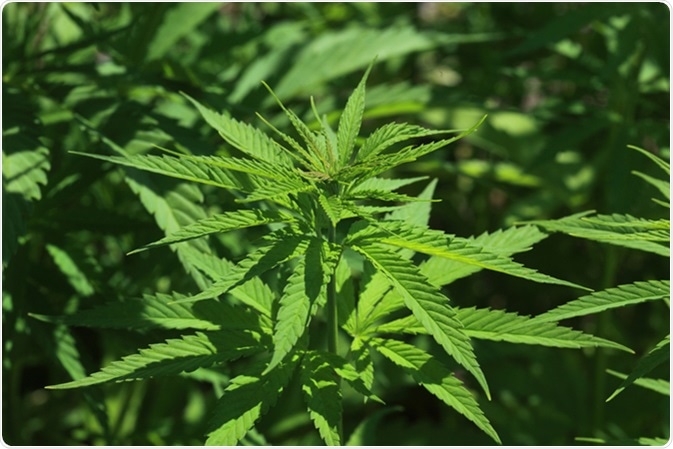Cannabis sativa is a herbaceous plant that represents a source of more than sixty aromatic hydrocarbon compounds known as cannabinoids, and among them delta-9-tetrahydrocannabinol (usually abbreviated as THC) is the main psychotropic constituent.

Cannabis sativa. Image Credit: BAO-Images Bildagentur / Shutterstock
Since cannabinoids are characterized by low water and high lipid solubility, their pharmacological properties were classically ascribed to the perturbation of biological membranes and their phospholipid components. Nevertheless, this changed in the late 1980s when specific cannabinoid receptors were discovered.
Furthermore, the existence of endogenous ligands that bind to these receptors (termed “endocannabinoids”) has also been demonstrated, pointing towards the pharmacological and physiological importance of cannabinoid receptors. Both the receptors and their endogenous ligands comprise the endocannabinoid system.
Properties and Distribution of Cannabinoid Receptors
Mammalian tissues are known to contain at least two types of cannabinoid receptors; these are CB1 and CB2 receptors, cloned in 1990 and 1993, respectively. Both of them are coupled through G-proteins, both positively to mitogen-activated protein kinase (MAPK) and negatively to adenylate cyclase.
CB1 receptors are widely found in the central nervous system, but are also found in some peripheral tissues such as the heart, lungs, reproductive organs, gastrointestinal tissues, pituitary gland, sympathetic ganglia, urinary bladder and adrenal glands. Those found at nerve terminals have the significant function of suppressing the release of a myriad of excitatory and inhibitory neurotransmitters.
Within the brain, there is a highly heterogeneous distribution of CB1 receptors, as their expression is found in the cerebral cortex, globus pallidus, substantia nigra, endopeduncular nucleus, hippocampus, cerebellum, and in some parts of thalamus and amygdala (as well as in some other regions).
On the other hand, CB2 receptors are predominantly found on immune cells (most notably natural killer cells and B-cells), where they play an important role in modulating cytokine release in both health and disease. Therefore, a common property of CB1 and CB2 receptors is the ability to modulate the continuous release of diverse chemical messengers – CB1 receptors from neurons and CB2 receptors from immune cells.
Ligands for Cannabinoid Receptors
Endogenous agonists specific for cannabinoid receptors are all eicosanoids. Among these endocannabinoids, arachidonoyl-ethanolamide (also known as anandamide) was among the first to be discovered, and there is compelling evidence that this ligand (as well as some of its metabolites) may also activate vanilloid VRI receptors.
Anandamide behaves as a partial agonist of cannabinoid receptors with slightly greater CB1 than CB2 affinity, but with much lower CB2 than CB1 efficacy. Other endocannabinoids (such as arachidonyl glyceryl ether and 2-arachidonoyl glycerol) show a similar pattern of affinity.
In any case, the above-mentioned distribution pattern of CB1 receptors accounts for several notable pharmacological properties of their agonists, e.g. their tendency to impair memory and cognition, as well as to alter the motor function control. It also accounts for the ability of these agonists to induce analgesia in humans.
The cannabinoid receptor agonists that have been used extensively in pharmacological experiments show equal binding affinity for both CB1 and CB2 receptors, or show merely marginal CB1 or CB2 selectivity. These are the classical cannabinoids (THC and HU-210), as well as the non-classical cannabinoid (CP55940) and certain aminoalkylindoles.
The discovery of cannabinoid receptors also instigated a quest for selective CB1 and CB2 receptor antagonists, with varying degrees of success so far. This is definitely a field of future research, which should also aim to develop strategies on how to separate the desired therapeutic effects of agonists from their undesirable consequences, specifically their psychotropic properties.
Sources
- https://www.ncbi.nlm.nih.gov/pubmed/7598509
- https://www.ncbi.nlm.nih.gov/pubmed/9336020
- https://www.ncbi.nlm.nih.gov/pubmed/16570099
- pdfs.semanticscholar.org/bc19/f6b7524d32154217fa1b4c74c727ed3a4fba.pdf
- Pertwee RG. New Developments in the Pharmacology of Cannabinoids. In: van der Goot, editor. Trends in Drug Research III: Proceedings of the 13th Noordwijkerhout-Camerino Symposium. Elsevier Science, 2002; pp. 249-258.
Further Reading